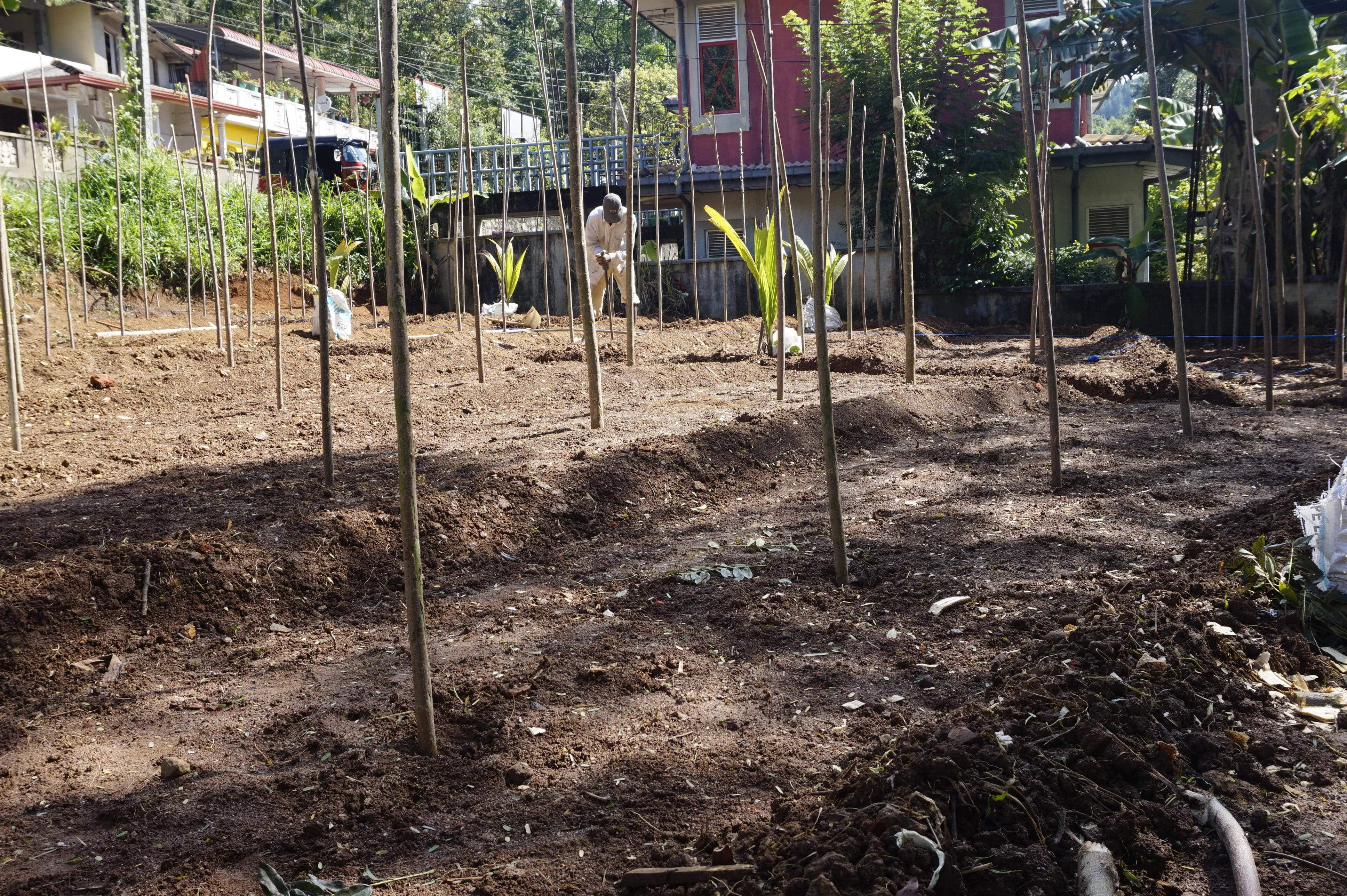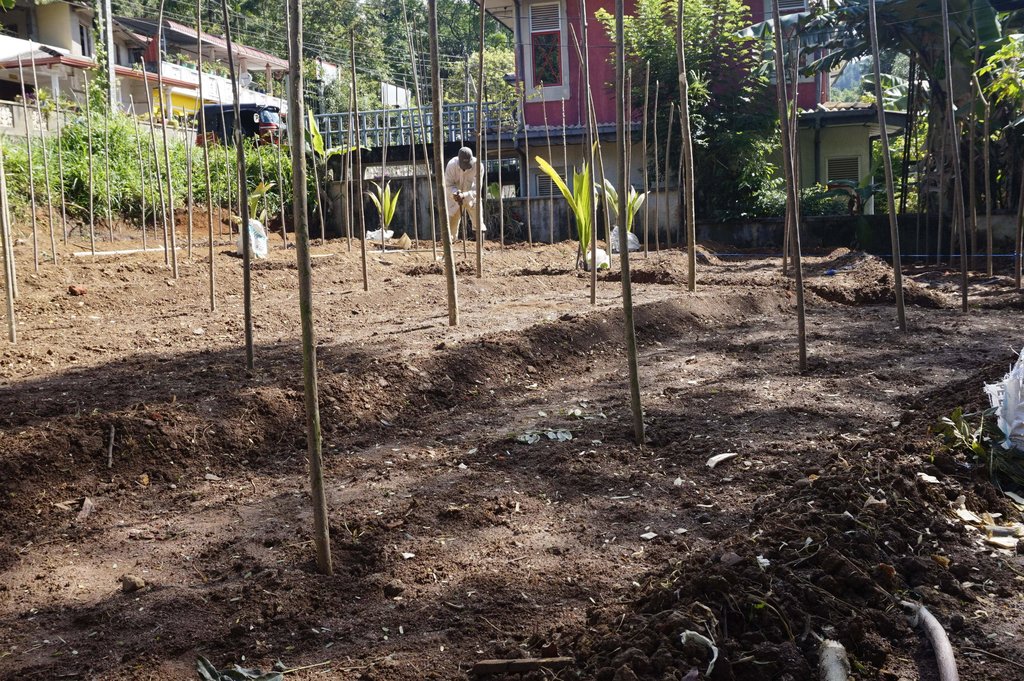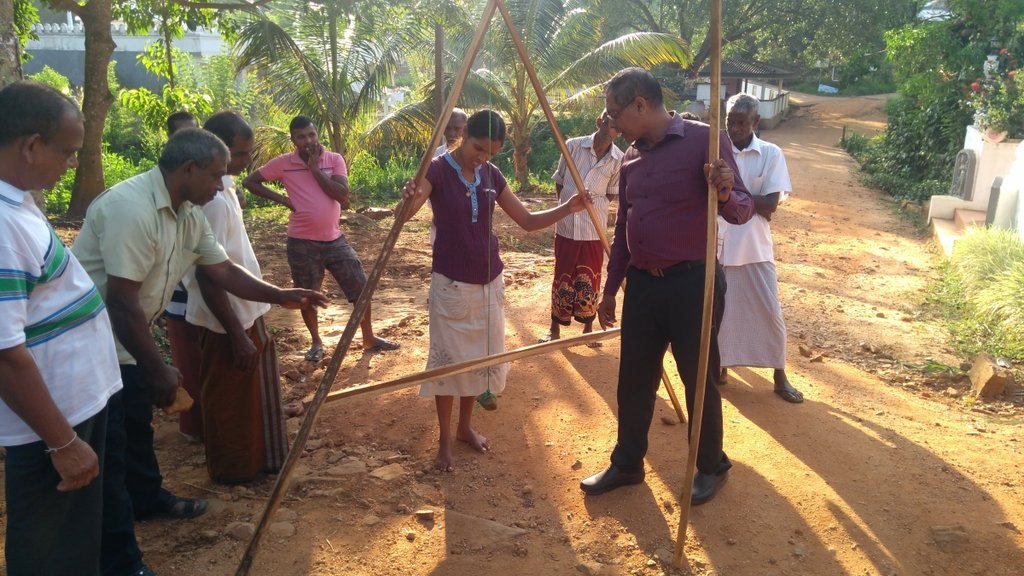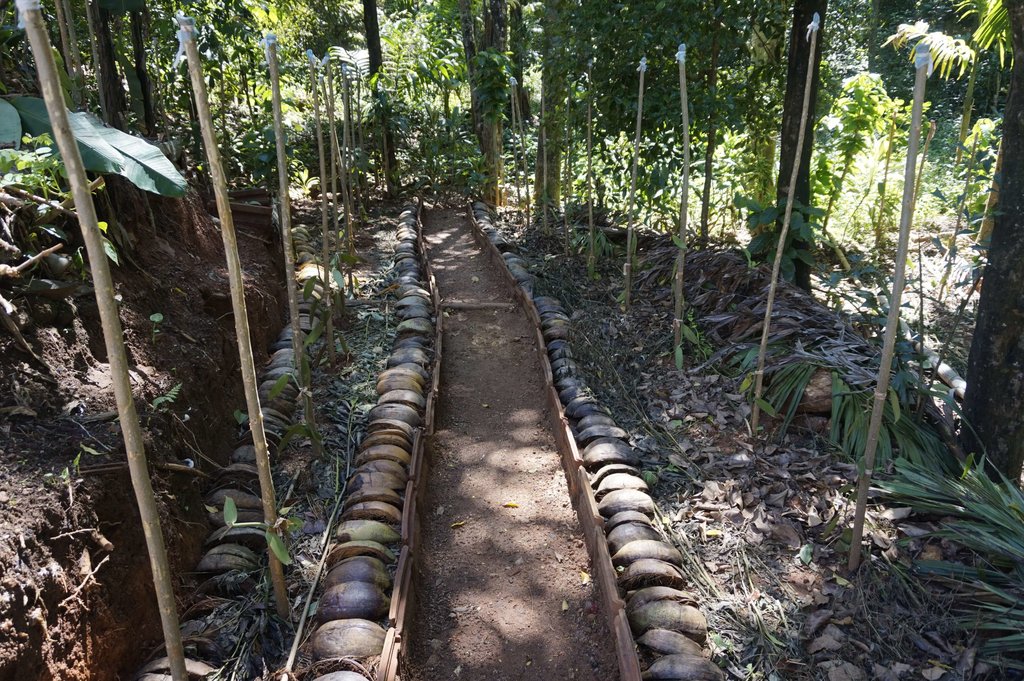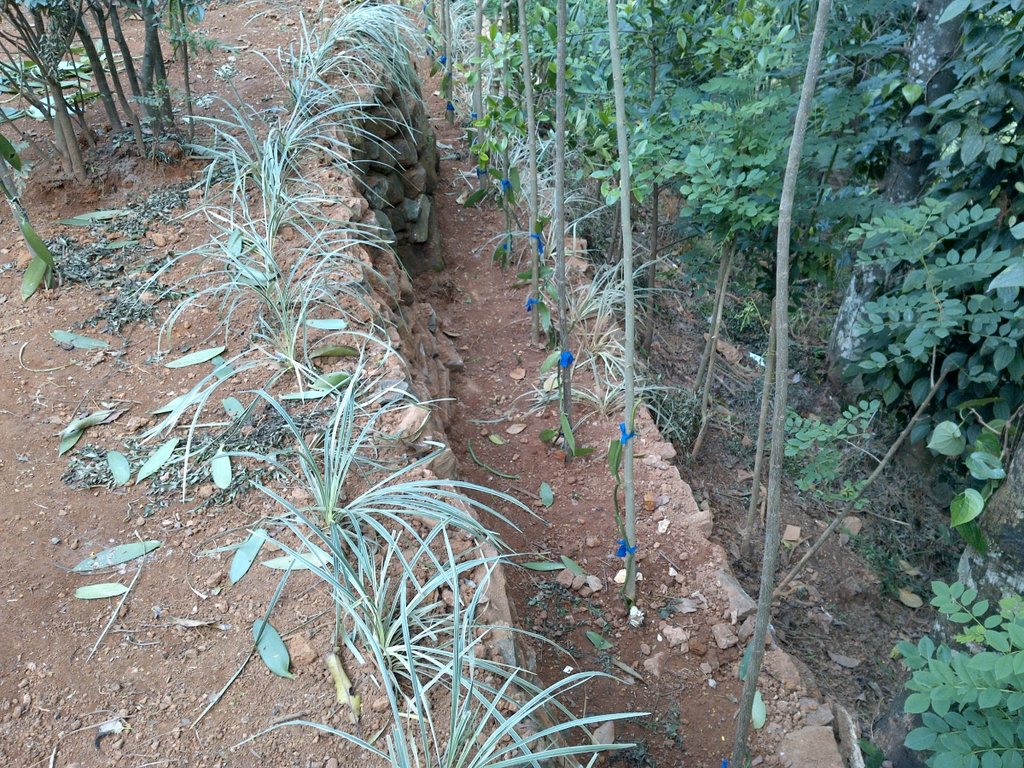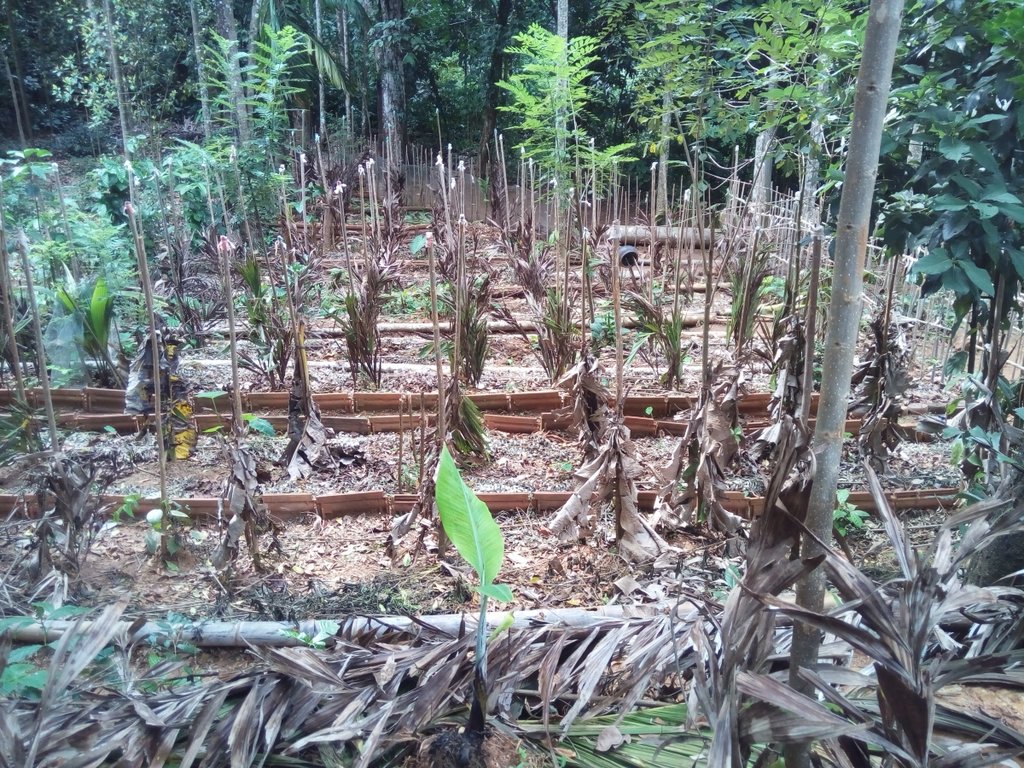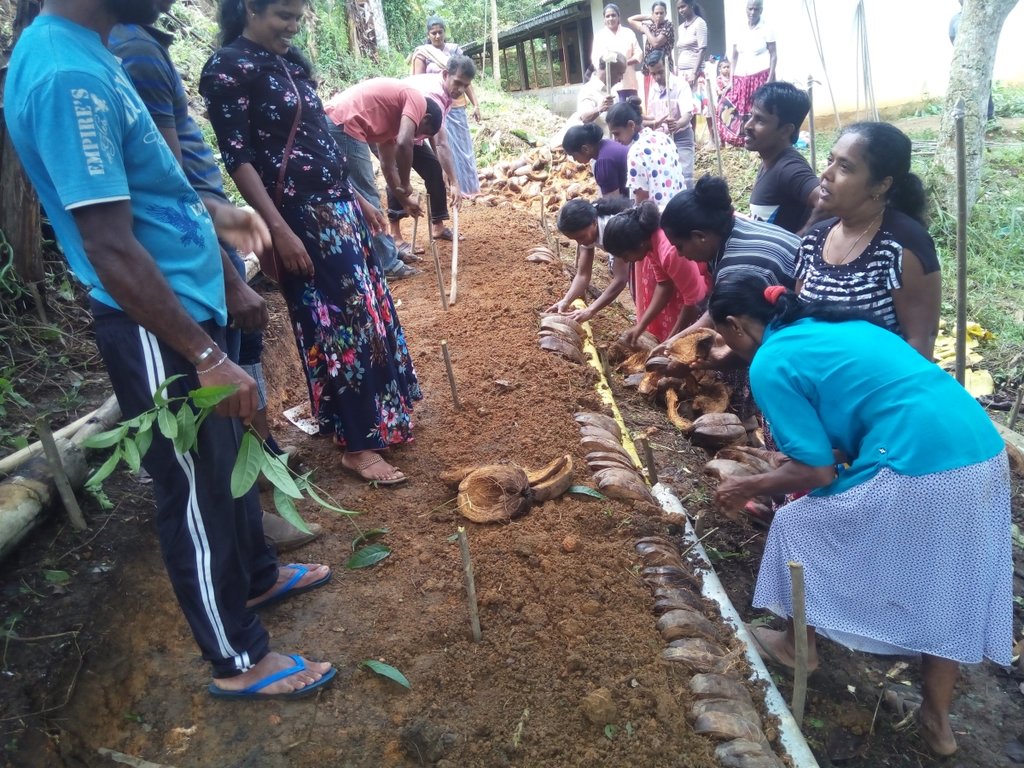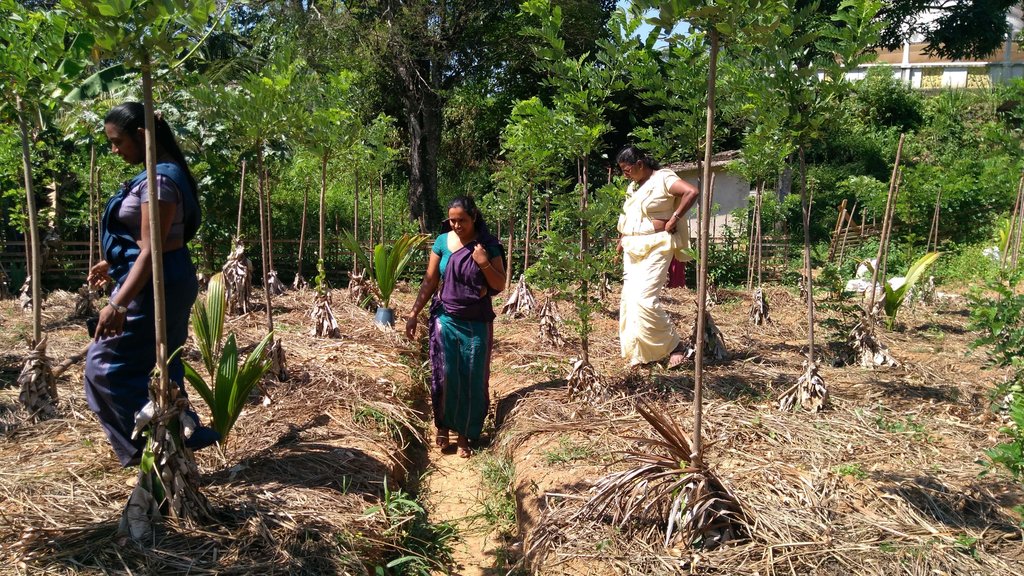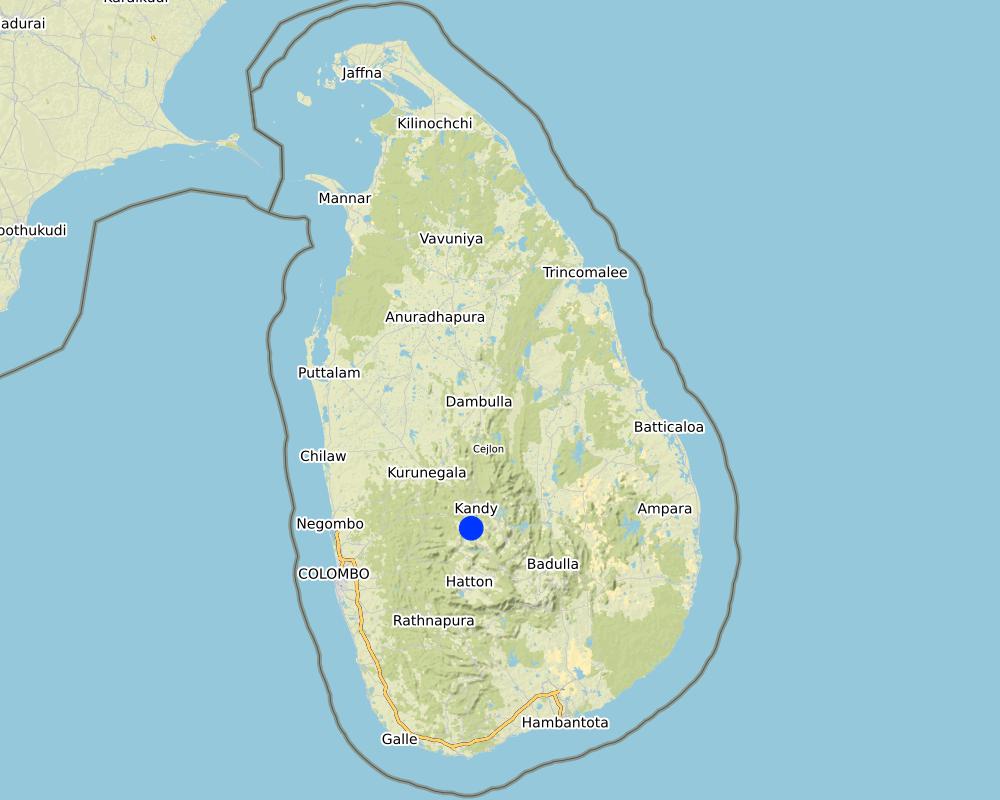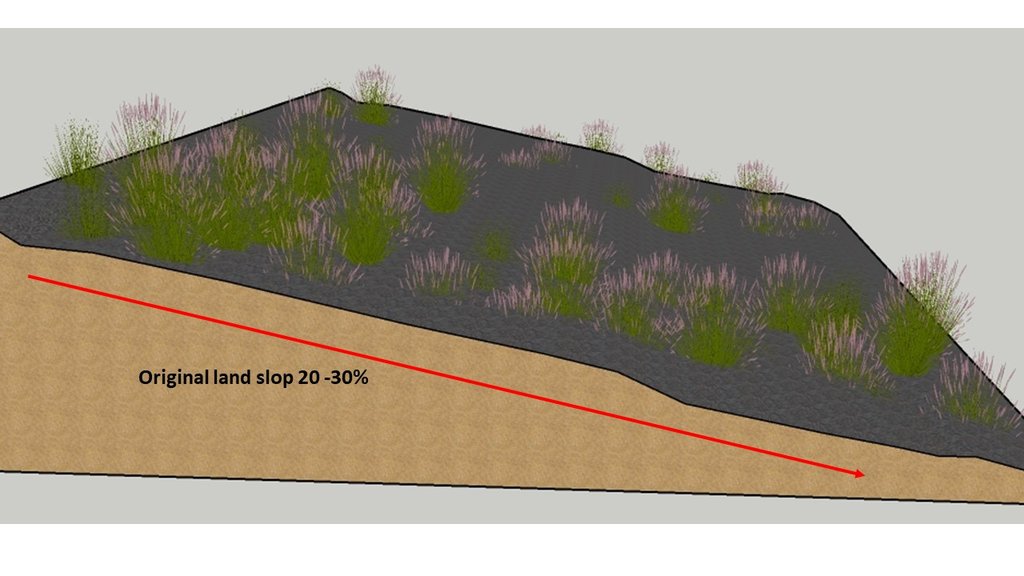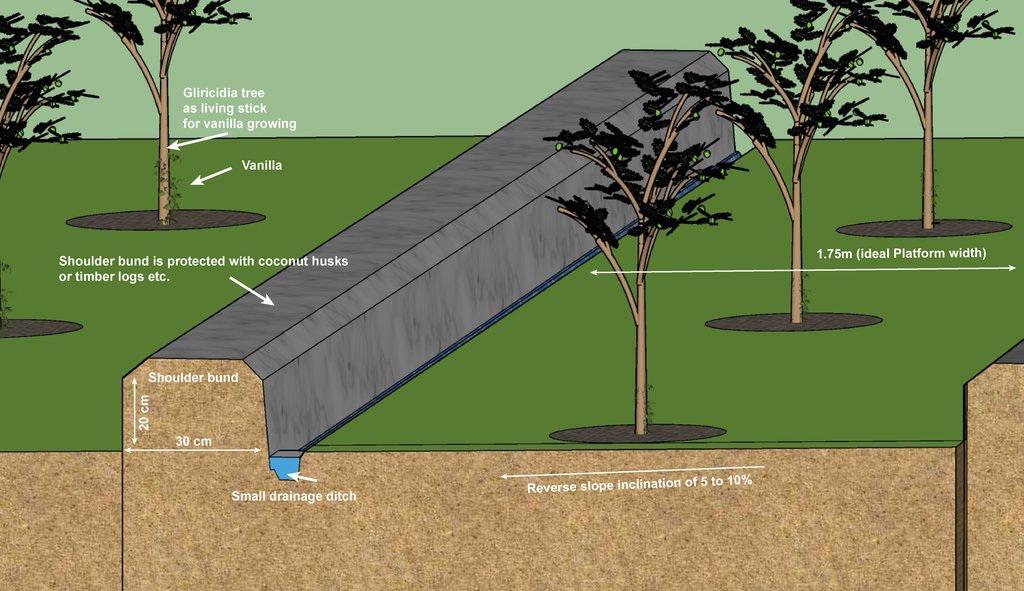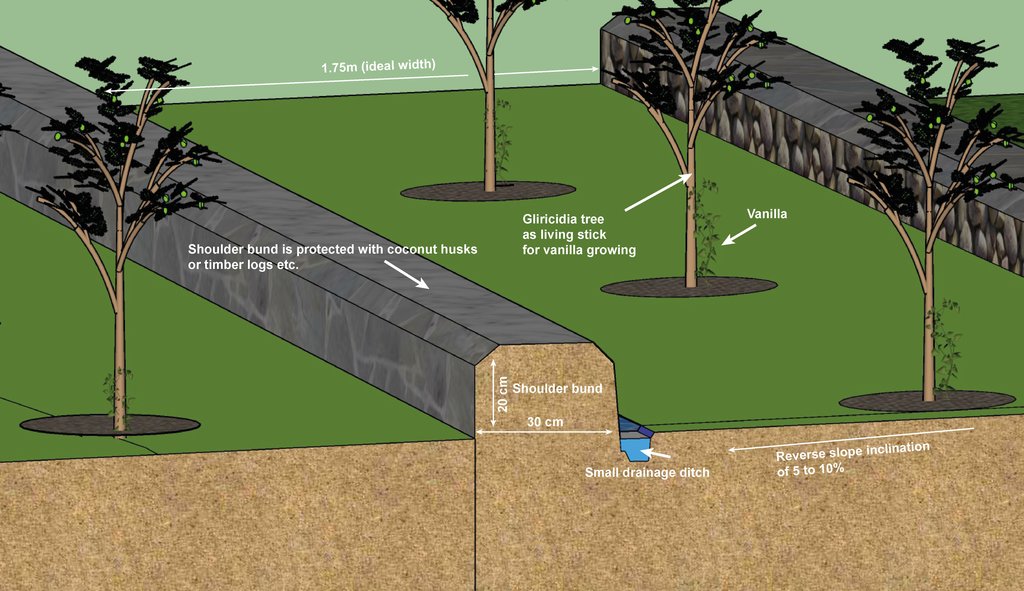Individual platforms and contour platforms [斯里兰卡]
- 创建:
- 更新:
- 编制者: Bandara Rotawewa
- 编辑者: –
- 审查者: Ursula Gaemperli, Rima Mekdaschi Studer
Thani wedika and samochcha wedika
technologies_5621 - 斯里兰卡
查看章节
全部展开 全部收起1. 一般信息
1.2 参与该技术评估和文件编制的资源人员和机构的联系方式
有助于对技术进行记录/评估的项目名称(如相关)
Rehabilitation of Degraded Agricultural Lands in Kandy, Badulla and Nuwara Eliya Districts in the Central Highlands of Sri Lanka1.3 关于使用通过WOCAT记录的数据的条件
编制者和关键资源人员接受有关使用通过WOCAT记录数据的条件。:
是
1.4 所述技术的可持续性声明
这里所描述的技术在土地退化方面是否存在问题,导致无法被认为是一种可持续的土地管理技术?:
否
1.5 参考关于SLM方法(使用WOCAT记录的SLM方法)的调查问卷
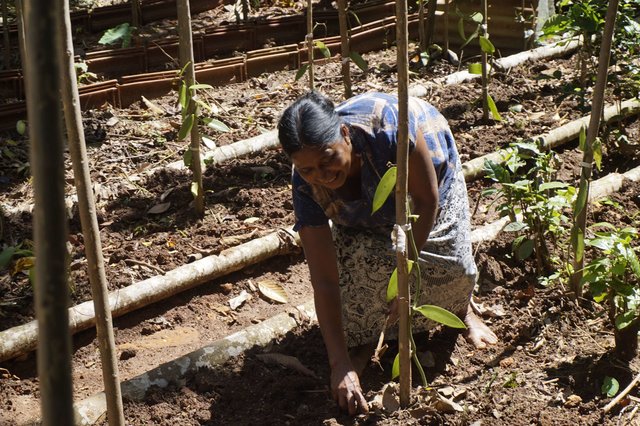
Women practices SLM through Vanilla cultivation [斯里兰卡]
Women in Central Highlands of Sri Lanka practice sustainable land management through vanilla cultivation and earn extra income for their families
- 编制者: Bandara Rotawewa
2. SLM技术的说明
2.1 技术简介
技术定义:
Construction of individual platforms or contour platforms to control soil erosion in the home gardens (HG) to cultivate vanilla as a cash crop
2.2 技术的详细说明
说明:
Doluwa is located in the Central Highlands of Sri Lanka. This area belongs to the Wet zone mid-country agro-ecological region according to Sri Lankan classification. The elevation of the area is 575 meters. The mean temperature of the area is about 24 °C. The area receives rainfall from two monsoons. North-east monsoon rain comes from November to January with an annual rainfall of 1800 mm. The South-west monsoon rain lasts from May to September and contributes a major portion of the annual rainfall. February, March, and July months receive lower rainfall. The Central Highlands have excellent agro-ecological conditions for tea plantations, spice crops like cloves, nutmeg and cardamom, fruit crops such as avocado, durian, coffee, banana, and black pepper. Paddy cultivation is practiced in the valleys. Areas over 50% of slope inclination are covered by protected forests. The main livelihood activity is agriculture: mainly cultivation of tea, spices, and vegetables. About 43% of the land is under tea cultivation; and around 15% is marginalized or abandoned land, due to land degradation and low productivity of soils.
The average land size of home gardens in the Central Highlands of Sri Lanka is about 0.25 – 0.5 acres. Fruits and spice trees randomly exist in these land plots. The topsoil is always disturbed due to daily human activities. Apart from run-off water from upper lands, rooftop rainwater flows in all directions causing heavy soil erosion in these home gardens. The home gardens are the least attended land plots in terms of conservation due to low-income generation.
Traditionally, home gardens with randomly planted perennial trees are usually shady. Therefore, farm families generally believe that cultivation of cash crops in their home gardens is impossible. The introduction of Individual Platforms and Contour Platforms as a soil conservation methodology, piloted in the Doluwa area by an FAO project on Rehabilitation of Degraded Agricultural in several Districts of the Central Highlands of Sri Lanka has proven the contrary, as mainly vanilla is known as a shade-preferring crop. Furhter, vanilla is economically highly valuable and has the potential to generate good income. Consequently, adequate platforms (small soil terraces) were constructed and used for vanilla cultivation. Vanilla grows particularly well where the soil organic matter content is high. Organic matter required to enrich the soil can be collected directly from the home gardens (leaves and residues) and is also coming from organic kitchen waste. These organic residues are recycled into compost and finally used for the cultivation of vanilla. Additionally, mulching is practiced to control topsoil erosion. Each vanilla plant as a tropical climbing vine grows up a previously planted two-meter-high Gliricidia stick. Gliricidia serves on the one hand as a living fixing stick and provider of shade and, as a leguminous tree (Fabaceae family) the plant has the potential to fix nitrogen in the soil.
Construction of the platforms:
The individual platforms are constructed around the planting hole and are one meter wide and two meters in length. The distance between the two platforms is the same (minimum 2 meters) as the space for the vanilla plant. The lower side of the platform (lower edge) has a shoulder bund, stabilized with coconut husk, tree logs, and stones.
The contour platforms are 1.75 meters in width and length depending on the land size and other characteristics. The platform is constructed with a slightly inverted gradient. A small drain with a suitable gradient along the length on the upper side of the platform is constructed to drain out excess water during rain. These small drains are connected to a leader drain. The edges of the platforms are well stabilized again by coconut husk, tree logs or stones (shoulder bund measure: height x width = 20cm x 30cm).
This sustainable land management (SLM) technology is highly accepted by the farm families, as the Vanilla SLM model is an economically attractive opportunity especially for women; but only where the environmental conditions are suitable for vanilla growing.
2.3 技术照片
2.5 已应用该技术的、本评估所涵盖的国家/地区/地点
国家:
斯里兰卡
区域/州/省:
Central
有关地点的进一步说明:
Doluwa
具体说明该技术的分布:
- 适用于特定场所/集中在较小区域
技术现场是否位于永久保护区?:
否
Map
×2.6 实施日期
注明实施年份:
2018
如果不知道确切的年份,请说明大概的日期:
- 不到10年前(最近)
2.7 技术介绍
详细说明该技术是如何引入的:
- 通过项目/外部干预
注释(项目类型等):
Rehabilitation of Degraded Agricultural Lands in Kandy, Badulla and Nuwara Eliya Districts in the Central Highlands of Sri Lanka
3. SLM技术的分类
3.1 该技术的主要目的
- 改良生产
- 减少、预防、恢复土地退化
- 结合其他技术保护流域/下游区域
- 创造有益的经济影响
3.2 应用该技术的当前土地利用类型
同一土地单元内混合使用的土地::
是
具体说明混合土地使用(作物/放牧/树木):
- 农林业

农田
- 一年一作
- 乔木与灌木的种植
- Vanilla
注释:
Crop types commonly found in these home gardens are cloves, nutmeg and cardamom, fruit crops of avocado, durian, coffee, banana, and black pepper
3.3 由于技术的实施,土地使用是否发生了变化?
同一土地单元内混合使用的土地::
否
3.4 供水
该技术所应用土地的供水:
- 雨养
3.5 该技术所属的SLM组
- 横坡措施
- 家庭花园
3.6 包含该技术的可持续土地管理措施

农艺措施
- A2:有机质/土壤肥力

结构措施
- S1:阶地
3.7 该技术强调的主要土地退化类型

土壤水蚀
- Wt:表土流失/地表侵蚀
- Wg:冲沟侵蚀/沟蚀
3.8 防止、减少或恢复土地退化
具体数量名该技术与土地退化有关的目标:
- 防止土地退化
- 减少土地退化
4. 技术规范、实施活动、投入和成本
4.1 该技术的技术图纸
技术规范(与技术图纸相关):
Slope gradient in home gardens before introduction of the SLM Technology.
作者:
Bandara Rotawewa
日期:
05/04/2020
技术规范(与技术图纸相关):
Contour platforms: the ideal platform is 175 cm wide. The length is depending on the available length of the land. The platform is constructed by cutting the upper section and fill in to the lower section to get an inverse slope of 5 to 10%. The shoulder bund is 30 cm wide and 20 cm height. The shoulder bund is protected with coconut husk/ timber logs etc.
Individual platform: The spacing between the two plants in the platforms is 1 - 1.5 meters. The individual platform size can be 100 cm wide and 200 cm in length. Coconut husks, stones, timber logs can be used to protect the edges of the platform.
作者:
Bandara Rotawewa
日期:
05/04/2020
4.2 有关投入和成本计算的一般信息
具体说明成本和投入是如何计算的:
- 每个技术区域
注明尺寸和面积单位:
0.25 acre
具体说明成本计算所用货币:
- 美元
注明雇用劳工的每日平均工资成本:
840 USD per 1/4 acre of land
4.3 技术建立活动
| 活动 | 时间(季度) | |
|---|---|---|
| 1. | Construction of contour or individual platform terraces | Before establishment of the crop |
| 2. | Reinforcement of the shoulder bunds with coconut husk/ tree logs/ etc | After construction of contour platform or individual platforms |
| 3. | Preparing of compost and mixing it into the top soil | Before establishment of the crop |
| 4. | Planting of vanilla rooted cutting | First Live Gliricidia sticks are planted. After they rooted, vanilla cuttings are planted) |
4.4 技术建立所需要的费用和投入
| 对投入进行具体说明 | 单位 | 数量 | 单位成本 | 每项投入的总成本 | 土地使用者承担的成本% | |
|---|---|---|---|---|---|---|
| 劳动力 | Construction of contour platforms in a quarter of Acre | person days | 40.0 | 15.0 | 600.0 | 100.0 |
| 劳动力 | Planting of vanilla rooted cutting | person days | 1.0 | 15.0 | 15.0 | 100.0 |
| 植物材料 | Gliricidia sticks | number | 200.0 | 0.2 | 40.0 | 100.0 |
| 植物材料 | Vanilla rooted cuttings | number | 200.0 | 0.4 | 80.0 | |
| 肥料和杀菌剂 | Preparing of compost and mixing it into the top soil | person days | 5.0 | 15.0 | 75.0 | 100.0 |
| 施工材料 | Coconut husk/ tree logs | pieces | 4005.0 | 0.03 | 120.15 | 100.0 |
| 技术建立所需总成本 | 930.15 | |||||
| 技术建立总成本,美元 | 930.15 | |||||
如果土地使用者负担的费用少于100%,请注明由谁负担其余费用:
The project on Rehabilitation of Degraded Agriculture Lands implemented by Food and Agriculture Organization of the United Nations and funded by Global Environmental Facility
4.5 维护/经常性活动
| 活动 | 时间/频率 | |
|---|---|---|
| 1. | Removal of overgrown grass and trimming of grass on the shoulder bunds | Twice a year (after the rainy season) |
| 2. | Repair of the broken places of the terrace, shoulder bunds etc | Once a year |
4.6 维护/经常性活动所需要的费用和投入(每年)
| 对投入进行具体说明 | 单位 | 数量 | 单位成本 | 每项投入的总成本 | 土地使用者承担的成本% | |
|---|---|---|---|---|---|---|
| 劳动力 | Removal of overgrown grass and trimming of grass on the shoulder bunds | Person days | 5.0 | 15.0 | 75.0 | 100.0 |
| 劳动力 | Repair of the broken places of the terrace, shoulder bunds etc | Person days | 3.0 | 15.0 | 45.0 | 100.0 |
| 技术维护所需总成本 | 120.0 | |||||
| 技术维护总成本,美元 | 120.0 | |||||
4.7 影响成本的最重要因素
描述影响成本的最决定性因素:
Steepness of the slope is greatly determining the labour cost requirement for the construction of individual platforms and contour platforms. The cost of coconut husk is another cost component for conservation.
Maintenance is mostly depending on ground grass cover and periodical maintenance.
5. 自然和人文环境
5.1 气候
年降雨量
- < 250毫米
- 251-500毫米
- 501-750毫米
- 751-1,000毫米
- 1,001-1,500毫米
- 1,501-2,000毫米
- 2,001-3,000毫米
- 3,001-4,000毫米
- > 4,000毫米
指定年平均降雨量(若已知),单位为mm:
2500.00
有关降雨的规范/注释:
Two monsoons: North-East monsoon is from November to December with an average monthly RF of 80 – 100 mm. Southwest monsoon is from April to July with an average RF of 108 – 200. First Inter monsoon is from January to March is with 180 – 200 mm RF while second inter monsoon with 300 – 350 mm of RF. February is the driest month of a year.
The minimum mean temperature is 200 Celsius and the maximum mean temperature is 240 Celsius and the annual mean temperature is 240 Celsius.
农业气候带
- 潮湿的
5.2 地形
平均坡度:
- 水平(0-2%)
- 缓降(3-5%)
- 平缓(6-10%)
- 滚坡(11-15%)
- 崎岖(16-30%)
- 陡峭(31-60%)
- 非常陡峭(>60%)
地形:
- 高原/平原
- 山脊
- 山坡
- 山地斜坡
- 麓坡
- 谷底
垂直分布带:
- 0-100 m a.s.l.
- 101-500 m a.s.l.
- 501-1,000 m a.s.l.
- 1,001-1,500 m a.s.l.
- 1,501-2,000 m a.s.l.
- 2,001-2,500 m a.s.l.
- 2,501-3,000 m a.s.l.
- 3,001-4,000 m a.s.l.
- > 4,000 m a.s.l.
说明该技术是否专门应用于:
- 不相关
5.3 土壤
平均土层深度:
- 非常浅(0-20厘米)
- 浅(21-50厘米)
- 中等深度(51-80厘米)
- 深(81-120厘米)
- 非常深(> 120厘米)
土壤质地(表土):
- 中粒(壤土、粉土)
土壤质地(地表以下> 20厘米):
- 中粒(壤土、粉土)
表土有机质:
- 低(<1%)
5.4 水资源可用性和质量
地下水位表:
5-50米
地表水的可用性:
中等
水质(未处理):
不良饮用水(需要处理)
水质请参考::
地下水和地表水
水的盐度有问题吗?:
否
该区域正在发生洪水吗?:
否
5.5 生物多样性
物种多样性:
- 中等
栖息地多样性:
- 中等
5.6 应用该技术的土地使用者的特征
定栖或游牧:
- 定栖的
生产系统的市场定位:
- 混合(生计/商业)
相对财富水平:
- 贫瘠
个人或集体:
- 团体/社区
机械化水平:
- 手工作业
性别:
- 女人
土地使用者的年龄:
- 中年人
5.7 应用该技术的土地使用者使用的平均土地面积
- < 0.5 公顷
- 0.5-1 公顷
- 1-2 公顷
- 2-5公顷
- 5-15公顷
- 15-50公顷
- 50-100公顷
- 100-500公顷
- 500-1,000公顷
- 1,000-10,000公顷
- > 10,000公顷
这被认为是小规模、中规模还是大规模的(参照当地实际情况)?:
- 小规模的
注释:
Home gardens
5.8 土地所有权、土地使用权和水使用权
土地所有权:
- 个人,有命名
土地使用权:
- 个人
用水权:
- 个人
土地使用权是否基于传统的法律制度?:
是
5.9 进入服务和基础设施的通道
健康:
- 贫瘠
- 适度的
- 好
教育:
- 贫瘠
- 适度的
- 好
技术援助:
- 贫瘠
- 适度的
- 好
就业(例如非农):
- 贫瘠
- 适度的
- 好
市场:
- 贫瘠
- 适度的
- 好
能源:
- 贫瘠
- 适度的
- 好
道路和交通:
- 贫瘠
- 适度的
- 好
饮用水和卫生设施:
- 贫瘠
- 适度的
- 好
金融服务:
- 贫瘠
- 适度的
- 好
6. 影响和结论性说明
6.1 该技术的现场影响
社会经济效应
生产
作物生产
注释/具体说明:
Before introducing the technology women did not think of vanilla cultivation. With technology, women realized vanilla as a cash crop, its potential for livelihood improvement.
作物质量
注释/具体说明:
Before introduction of the technology, vanilla growing suffered from soil erosion and poor soil quality
生产故障风险
土地管理
水资源可用性和质量
饮用水的质量
收入和成本
农业收入
收入来源的多样性
经济差异
工作量
社会文化影响
食品安全/自给自足
社区机构
注释/具体说明:
Women were formed as a group for training arrangements, and for marketing purposes.
SLM/土地退化知识
注释/具体说明:
The project provided practical training on SLM.
生态影响
水循环/径流
水质
注释/具体说明:
Reduced soil erosion made this possible
地表径流
注释/具体说明:
contour platforms reinforced with coconut husk and tree logs reduce the runoff speed and quantity.
土壤
土壤水分
注释/具体说明:
reduced run off and increased organic matter content.
土壤流失
土壤有机物/地下C
注释/具体说明:
Addition of compost increased the soil carbon content.
6.2 该技术的场外影响已经显现
下游淤积
注释/具体说明:
this happened as a result of reduced runoff
地下水/河流污染
注释/具体说明:
this happened as a result of reduced runoff
对邻近农田的破坏
注释/具体说明:
this happened as a result of reduced runoff
6.3 技术对渐变气候以及与气候相关的极端情况/灾害的暴露和敏感性(土地使用者认为的极端情况/灾害)
渐变气候
渐变气候
| 季节 | 增加或减少 | 该技术是如何应对的? | |
|---|---|---|---|
| 季节性温度 | 旱季 | 减少 | 适度 |
气候有关的极端情况(灾害)
气候灾害
| 该技术是如何应对的? | |
|---|---|
| 干旱 | 适度 |
6.4 成本效益分析
技术收益与技术建立成本相比如何(从土地使用者的角度看)?
短期回报:
积极
长期回报:
积极
技术收益与技术维护成本/经常性成本相比如何(从土地使用者的角度看)?
短期回报:
积极
长期回报:
积极
6.5 技术采用
- > 50%
在所有采用这项技术的人当中,有多少人是自发的,即未获得任何物质奖励/付款?:
- 11-50%
6.6 适应
最近是否对该技术进行了修改以适应不断变化的条件?:
否
6.7 该技术的优点/长处/机会
| 土地使用者眼中的长处/优势/机会 |
|---|
| The home gardens that were unproductive is now used for income generation |
| The aesthetic view of the land increased |
| Simple technology |
| Low cost and affordable |
| 编制者或其他关键资源人员认为的长处/优势/机会 |
|---|
| Land unit production is increased |
| Farmers gained knowledge in sustainable land management techniques such as use of A – Frame for contour marking. |
| Use of kitchen waste and other vegetative materials for composting is increased |
| Conserve top soil moisture and reduce soil erosion |
6.8 技术的弱点/缺点/风险及其克服方法
| 土地使用者认为的弱点/缺点/风险 | 如何克服它们? |
|---|---|
| 1)The contour terraces may damage by thunderstorm | Enforcement of edges of the (contour/individual) platforms with coconut husk, timer logs and establish leader drains |
| 编制者或其他关键资源人员认为的弱点/缺点/风险 | 如何克服它们? |
|---|---|
| The farmers’ awareness of technology and its’ impact is low. Therefore, adaptation/dissemination is low. | Farmer motivation and exposure visits are essential activities |
7. 参考和链接
7.1 信息的方法/来源
- 实地考察、实地调查
- 与土地使用者的访谈
- 与SLM专业人员/专家的访谈
(现场)数据是什么时候汇编的?:
15/06/2019
7.2 参考可用出版物
标题、作者、年份、ISBN:
Women practice SLM through Vanilla cultivation [Sri Lanka]
可以从哪里获得?成本如何?
No cost
7.3 链接到网络上的相关信息
标题/说明:
WOCAT Approach
URL:
https://qcat.wocat.net/en/wocat/approaches/view/approaches_5177/
7.4 一般注释
Easy to complete the technology.
链接和模块
全部展开 全部收起链接

Women practices SLM through Vanilla cultivation [斯里兰卡]
Women in Central Highlands of Sri Lanka practice sustainable land management through vanilla cultivation and earn extra income for their families
- 编制者: Bandara Rotawewa
模块
无模块


